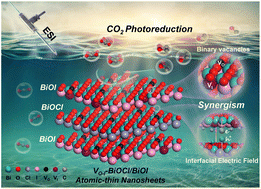Synergism of oxygen–iodine binary vacancies with the interfacial electric field: enhancing CO2 photoreduction over VO–I-BiOCl/BiOI atomic-thin nanosheets†
Abstract
The synergism of binary vacancies with the interfacial electric field could be efficient for improving CO2 photoreduction but is hindered by thermodynamic preparations and strict restrictions in lattice mismatches and component selections. Herein, atomic-thin nanosheets of the VO–I-BiOCl/BiOI heterojunction were simply constructed by a cascade electrospray (ESI)-annealing preparation method, achieving the synergism of oxygen–iodine binary vacancies with the interfacial electric field. Demonstrated by experiments and theoretical calculations, the interfacial electric field was successfully constructed to expedite the photogenerated electron–hole separation/transfer. Moreover, oxygen–iodine binary vacancies tuned the surface electronic structures to decrease the activation energy barrier and form a stable rate-limiting *COOH intermediate. Upon the synergism of binary vacancies with the interfacial electric field, CO2 photoreduction was promoted to significantly enhance the selective reduction of CO2 to CO (31.9, 24.5, 2.59, and 1.25-times higher than that of pure BiOCl, BiOI, and unitary vacancies of VO-BiOCl/BiOI and VI-BiOCl/BiOI). This has inspired a new engineering strategy for the synergism of oxygen–iodine binary vacancies with the interfacial electric field, contributing to the improvement of solar-energy-driven conversions.

- This article is part of the themed collection: Journal of Materials Chemistry A HOT Papers


 Please wait while we load your content...
Please wait while we load your content...